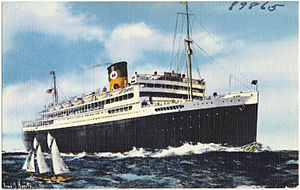 Artist's impression of the ship as SS Uruguay,
1938–41 or 1948–54 | |
| History | |
|---|---|
| Name |
|
| Namesake | |
| Owner |
|
| Operator |
|
| Port of registry | New York[1] |
| Route |
|
| Builder | Newport News Shipbuilding[1] |
| Yard number | 315 |
| Laid down | 20 March 1926 |
| Launched | 1 October 1927 |
| Sponsored by | Mrs. Roland Palmedo |
| Completed | January 1928[1] |
| Maiden voyage | 28 January 1928 |
| In service | 1928 |
| Out of service | 29 March 1954[5] |
| Renamed | SS Uruguay in 1938[2] |
| Refit | 1938, 1942, 1947[5] |
| Homeport | New York |
| Identification |
|
| Fate | Scrapped 1964[5] |
| General characteristics | |
| Type |
|
| Tonnage | |
| Displacement | as Uruguay: 32,450 tons[5] |
| Length | 574.4 ft (175.1 m) p/p[1] |
| Beam | 80.3 ft (24.5 m)[1] |
| Depth | 20.5 ft (6.2 m)[1] |
| Installed power | 2,833 NHP[1] 17,000 shp[7] |
| Propulsion |
|
| Speed | |
| Range | 3,300 nautical miles (6,100 km)[8] |
| Capacity | 4,473 troops;[8] 212,325 cubic feet (6,012 m3) cargo[8] |
| Sensors and processing systems | direction finding[1] equipment; gyrocompass (from 1934)[6] |
| Notes | |
SS California was the World's first major ocean liner built with turbo-electric propulsion.[9] When launched in 1927 she was also the largest merchant ship yet built in the US,[10] although she was a modest size compared with the biggest European liners of her era.
In 1938 California was renamed SS Uruguay.[2] From 1942 to 1946 she was operated through agents by the War Shipping Administration as the troopship Uruguay.[4] She was returned to civilian service as SS Uruguay in 1948, laid up in 1954 and scrapped in 1964.
- ^ a b c d e f g h i j k l m n o Lloyd's Register, Steamers & Motorships (PDF). London: Lloyd's Register. 1933. Retrieved 19 May 2013.
- ^ a b c d e Lloyd's Register, Steamers & Motorships (PDF). London: Lloyd's Register. 1940. Retrieved 20 May 2013.
- ^ a b Harnack 1938, p. 413.
- ^ a b Wardlow 1999, p. 222.
- ^ a b c d e f g Vinson, Bill; Casey, Ginger Quering. "S.S. Uruguay". Welcome Aboard Moore-McCormack Lines. Retrieved 20 May 2013.
- ^ a b Lloyd's Register, Steamers & Motorships (PDF). London: Lloyd's Register. 1934. Retrieved 19 May 2013.
- ^ Draper 1930, p. 899.
- ^ a b c Vinson, Bill; Casey, Ginger Quering. "S.S. Uruguay Memories & Photos Page 2". Welcome Aboard Moore-McCormack Lines. Retrieved 20 May 2013.
- ^ Harnack 1938, p. 303.
- ^ "Panama Pacific Lines finished". Time. Michael L Grace. 9 May 1938. Retrieved 19 May 2013.